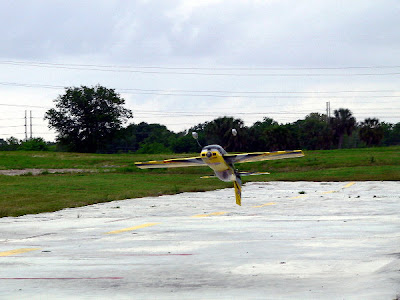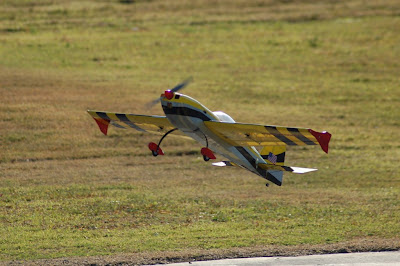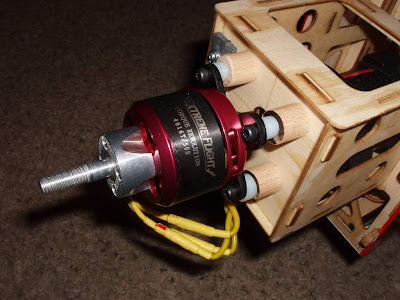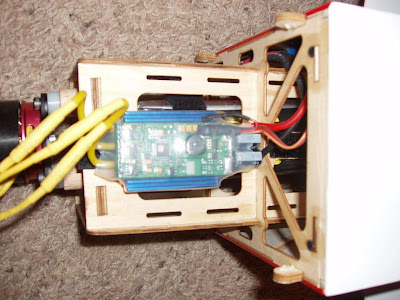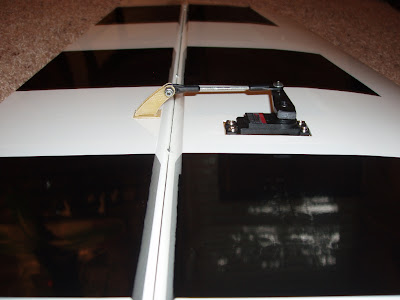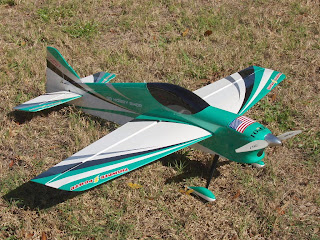Airframe: 3D Hobby Shop 47" Extra SHP
Wingspan: 47.25 inches
Length: 44 inches
Wing Area: 464 square inches
Weight: 37-41 ounces
Motor: Torque 2818-900 Kv Brushless Outrunner Motor
Weight: 104g
max sustained current: 35 amps
Batteries:
Thunder Power 3s 2200-3300 Extreme Series V2
Available from: http://3daero.com/ and other fine 3D Hobby Shop dealers
WHY THE EXTRA SHP FOR SPORT FLYING?
Some of you may not be familiar with 3D Hobby Shop, but you will be. The airplanes are too good not to make their way into the sport market, but so far 3D Hobby Shop has only pursued the 3D market, and has catered exclusively to it's rabid following of 3DHS junkies.
Like all of 3D Hobby Shop's planes, the Extra SHP is built and finished extremely well. The construction is light where strength isn't needed, and robust where it is. 3D Hobby Shop has also recently upgraded it's hardware package and all of it is absolute top shelf stuff (though the old hardware was still really good too). The fit and finish of all the parts is excellent, if not an industry standard.
Also worthy of note is that 3D Hobby Shop's technical support and customer service departments are absolutely second to none in the industry. This is not just my experience. Read any of the 3D Hobby Shop threads on this or any other forum, and they are chocked full of a legion of faithful customers who will fly nothing else. Of course, as with any mass produced item, 3D Hobby Shop very occasionally gets one with a minor problem or shipping damage, but 3D Hobby Shop is painfully keen to make these right as soon as possible....like maybe yesterday. Technical support often goes way past above and beyond, and if you have a set up issue or even a question about flying technique, the best and most friendly help in the industry is a phone call, email, or forum private message away.
Other manufacturers please take note.
New Review Formatting
This report will be formatted a little differently from our previous projects. This time, because the flying is so important, we will get to that first. After that we can delve into the specifics of setup and equipment.
FLYING
The first Extra SHP that we set up for sport use belongs to long time friend, flying buddy and Mystery Aviation Development Team pilot Don Wilson. The day before the following video I flew a 5 minute test hop, and Don finished the day out with it. I took it home, made a few changes (mostly tidying up the wiring and checking everything), and the next day we made this video.
Subsequently we set an SHP Sport up for my friend and Mystery Aviation Development pilot, Doctor Who. Here's the video of his first flight with his new SHP Sport:
Even with a milder sport set up the Extra will still loop, roll, spin, knife edge, and perform any other conventional aerobatic maneuver. She will even do a loose blender, which sort of surprised me. She won't 3D like this, but that's not what we are after here.
What we are going after here is a plane that you can take out on Sunday and just fly it. We wanted the Extra Sport to be tame enough that inexperienced pilots could confidently learn aerobatics on her, but at the same time we wanted the Extra Sport to be capable of wild enough aerobatics to keep the experienced pilots entertained. That's a pretty huge window for a plane to fill up, but the Extra does it better than any plane I've ever seen. On top of that, a setup change is all that's required to turn the Extra into a 3D trainer, and then a wilder setup turns the Extra into a 3D monster. Smaller steps in setup will give you everything in between, and the plane responds beautifully to this.
This is an extremely diverse and adaptable airframe. It is capable of world class 3D performance, but tuned down a novice can use it to hone his aerobatic skills and learn new maneuvers. I am almost convinced that with a little further detuning the Extra SHP would be a suitable basic trainer, and it has actually been done.
With a 3 cell setup on the Torque 2818, takeoff roll at half throttle was about 20 feet. If you punch it the thing jumps right up in about five feet. Like most taildraggers, the Extra will require a little right rudder to keep her tracking straight down the runway, but if you just hammer it the plane takes off in such a short space that it doesn't really matter. You can do a nice, long, smooth takeoff if that's what you like, and the Extra is really good at it. I'm just too impatient for that and want to get in the air.
In the air the Extra Sport is very precise. It goes where you point it, stays where you point it, and doesn't do anything you don't tell it to do. It is very much like a good pattern ship in this respect. It is very solid and reassuring to fly because you are flying the plane instead of it flying you. The Extra tracks so well that it is easy to fly. You aren't fighting it the whole time to make it go where you want it to go. You simply point it where you want it to go and it goes there until you tell it to do something else.
This means you can just relax between maneuvers instead of constantly working and wearing yourself out. Even in 3D trim the Extra is so solid and tracks so well that the flights seem entirely too short. With some other planes, I am slap worn out after a hard flight. With the Extra, it's not unusual for me to fly four intense flights in a row, right on the deck, pausing only long enough to change out the battery, then burn all my packs up and be wishing I had more. And, that's in 3D trim. In sport trim it's even easier to fly.
Below is the first flight of my own Extra Sport and the Torque 2818 motor. I went right into my routine and so comfortable so instantly that I forgot to even trim the plane. She was handling so beautifully that I just flew her. Halfway through I remembered to trim her, but she didn't take any. This has happened exactly twice in 35 years of R/C modeling. the other time was my first Extra SHP!
Even in a hard turn at slow speed the Extra will resolutely refuse to surprise the pilot. Oh, sure, you can stall the plane like that, but it's not going to violently spin itself into the ground with no warning like some planes will do. It's not even going to spin and it certainly isn't going to snap out on you. It's just going to stall, and by the time you have soloed you'de better already know how to handle that anyway.
At the other end of the flight envelope the Extra goes fast very well. It's not flighty or darty and it holds it's heading so well I think we could pylon race the things against each other and it would be a hoot.
The Extra spins and snaps well, which is sort of surprising because inherent stability usually makes this impossible. In a snap you are putting the plane in an extremely unstable position, and stable planes just won't let you do that to them. The Extra, however, doesn't seem to mind, but as soon as you let off the sticks she goes right back to being an obedient, submissive puppy dog. When you snap or spin the Extra, just let go of the sticks when you're done and she will stop right now. This way you can exit these maneuvers exactly where you want to, then fly out and relax until you are ready for the next maneuver.
And that's the point when you are learning aerobatics. Put the plane where you want it to go. Anything else is just slop, like falling off a bicycle and then saying "I meant to do that." When you have a plane that goes exactly where you put it, that just makes learning to put it where you want it that much easier. The Extra's ability to do this makes it an incredible aerobatic trainer.
For the experienced sport pilot, the Extra's stability allows him to push it harder than ever before without the fear that the plane is going to bite him. It doesn't take very long at all to get a good feel for what the airplane is capable of, and that instills a lot of confidence. When you have that much confidence in a plane and are that comfortable flying it, you can pull off the most outrageous antics imaginable. This is the kind of plane that your skills grow with, even if you don't consciously practice and just fly instead.
For 3D? The Extra SHP was my 3D trainer. First I sport flew it with a mild 3D setup. As I learned more 3D maneuvers those crept into my sport routine. Eventually I needed a more wild setup to do the advanced maneuvers until eventually I had dialed in a full 3D setup and was flying 3D full time. Now I'm back to sport flying a second Extra, just for grins.
As you can see, the Extra SHP is a plane you can learn aerobatics with and progress right through to the most difficult 3D maneuvers. The Extra really can be almost anything you want it to be. All you have to do is tinker with the setup and get it the way you like it.
In summary, I could have just said that the Extra is so easy to fly that the average pilot will look like a hero in no time flat.
FINAL NAIL
There isn't much to be said about the Extra SHP's 3D abilities that hasn't been chronicled on over 500 pages of threads devoted to this plane on RC Groups and here on this blog. It is absolutely the 3D plane of choice for many, whether it be a 3D trainer, daily 3D beater, or all out 3D monster show off plane.
It does seem a little strange the plane's 3D abilities are so good that no one ever thought to try it as a sport plane and report on it as such. The Extra SHP is so good at what it does that no one thought to try something else with it, but the plane is an extremely capable sport flier. The plane can be used for everything from basic aerobatic training all the way through the most advanced 3D maneuvers, or it can be dialed back and flown around on Sundays just for fun.
There are a lot of good sport planes out there. I'de say in all my years of sport flying that the Extra SHP Sport is probably the best flying of all of them.
So, it seems the 3D Hobby Shop Extra SHP is probably the best kept secret in the sport flying industry. Once people read this report and see the videos, I'm thinking that might be over.
EXTRA SHP THE ARF
Like all our other 3DHS planes, the Extra SHP came triple boxed, on time, and with no damage. Also like with our other 3DHS planes, all the necessary hardware was included. Outside of the power and radio system, you won't spend a dime finishing this baby up. I really love the guys at my LHS, but it was nice for a change to open the box and finish the entire project without having to make a mad run down there for parts. You're always missing something...... a screw, a servo extension, Velcro, a wire tie or even a wheel collar, but not when you get the plane and power system combo with servos. Everything I need except for the transmitter and receiver comes in the brown truck.
For all our 3DHS projects, we now use all the hardware and follow the directions exactly to the letter with absolutely zero deviation. In the past I have been persnickety about things like control horns, push rod keepers, and such, but any time I have had the bright idea use something different than comes in the box, it has turned out to be a mistake. Eventually I realized the guys in Fredricksburg know exactly what they are doing, and we now use 3D Hobby Shop hardware exclusively, even when we test another brand of plane.
Of course, for the Extra SHP Sport project, while all the hardware, servo, and power system components will be the same as we use for 3D flying, we will be using a different control set up, but more on that later.
Like with all our 3DHS projects, the covering was well done.....exceptionally well done. My personal SHP is done up in the now classic yellow and black bumble bee scheme, and boy is it loud. I like this scheme because, first, I like yellow, and most importantly, it is very easy to see and keep orientation of. There is never any doubt which way this baby is headed. I hope 3DHS makes the yellow in 55" some day, because I want one. Of course, the blue and white scheme is nice too, but us old blind guys really need the yellow.
We have lost track of how many 3DHS projects we have put together and flown. This is complicated by the fact that we have recently set up a whole new batch of them for guys in my club who have discovered what a step up is to be flying these planes. Personally, I own, have owned, and fly so many 3DHS planes that I think I'm qualified to say something about the level of quality in these kits. These are the finest mass produced items I have yet seen. They come beautifully turned out and we've never had a quality issue of any kind. We have never had to send anything back and we've never had to fix something that wasn't done right. All we do is assemble them by the book, and fly them really, really hard. They work just like they are supposed to.....if not better.
Other manufacturers please take note.
THE SETUP
First, I suggest you fly the plane on our recommended low rates for a bit and get used to it. If that's not enough throw for you, flip to high rate. Our set up is simply a good place to start off at. If your personal tastes want more or less, by all means, tailor the set up to what you are comfortable with,
We didn't use a lot of calculus or black magic to hit the set up on this plane. We didn't do a lot of research either. It was mostly pure dumb luck to have hit it dead on to begin with, but I do have over 200 flights on my Extra SHP in 3D trim. Not knowing where to start I simply measured the low rates on my Extra SHP and used those as the high rates on the Extra Sport. Then I tamed the low rate down a bit, moved the battery forward a bit, and we had a sport plane!
Mechanically we used the double servo arm (with one arm cut off) that comes with the HS65 servo, We put the push rod in the second hole from the inside on the servo arm (third hole for the rudder), and on the new 3D hobby Shop phenolic control horns there is only one hole anyway, so it can't possibly get any simpler.
Ailerons
I set my sport planes up at full deflection to do three rolls in five seconds, and I also use this for low rates on my 3D planes. Three roll in five seconds is a very comfortable roll rate for cranking of consecutive rolls and keeping the plane level with little jabs of up and down. Much faster than that and most people have trouble keeping up with it.
Elevator
For elevator on a sport setup I usually keep adding more until I start to lose smoothness, and then I back it off a notch. Low rate is pretty docile, but on high she becomes fairly lively.
Rudder
For high rate rudder I go for all I can steal. For low rates, most experienced pilots prefer full rudder, but newer guys might find that too hard to deal with on take offs and such. At least for the first few flights, try the rudder on low rate, and if it isn't enough, crank it up.
On our Extra Sport, we run the end points at 100% (minus whatever you need to keep the rudder from hitting the elevator) and since the setup was so perfect we never changed them. If you need a little more or less, use the end point controls or rates to tailor it to your tastes.
Exponential
In 3D you run massive exponential, but for sport flying the plane is comparatively pretty tame. Until recently I didn't even use any at all. With a little experimenting I have found that 30% (negative if you are using Futaba) is just enough to knock the edge off the handling without numbing the plane down. For this project we used that on both high and low rates. It's not a lot of expo and all it really does is make the plane seem to fly a little smoother. Of course, this isn't chiseled into stone or anything. If you want more or less, knock yourself out and dial it in. Get the plane exactly where you want it. Our setup is just a good starting point, but it works so well for us that you probably won't change much.
If you want to be ultra precise with your setup, these are the measurements we came up with for control throw:
Extra 300 Sport Setup
Ailerons High: 1 3/4"
Ailerons Low: 1/2"
Elevator High: 1 3/8"
Elevator Low: 1"
Rudder High: All you can get
Rudder Low: 3"
Throws are for each direction. CG: 3" to 3.25" behind the leading edge of the wing, measured where the wing meets the fuselage
Personally, I like 30% exponential (negative for Futaba users) on all surfaces for both high and low rates.
Center Of Gravity
For setting the CG we wanted to go a little further forward than what the manual calls for when flying 3D. We ran 2200 3S packs, and we also ran a few 3300 3s packs. On the first flight I moved the battery as far forward as it would go while still being able to get the Velcro strap secured around the it and this seemed to be just fine. We also moved it all the way back against the wing tube and it didn't seem to make much difference, so I'm not really sure that it matters.
My students prefer to run it toward the front because it makes the plane more stable, and I like it toward the rear because the plane snaps and spins a little better when more tail heavy. Either way, the plane is very steady, smooth and forgiving. Anymore I just jam the battery in and don't really care where it lands as long as it's on the tray and I can strap it down. Since the 3300 pack is heavier, we like to push that one all the way back against the spar, and while this comes out the most nose heavy configuration we tried, the Extra was still delightful to fly and even more stable than the others.
For setting the CG we wanted to go a little further forward than what the manual calls for when flying 3D. We ran 2200 3S packs, and we also ran a few 3300 3s packs. On the first flight I moved the battery as far forward as it would go while still being able to get the Velcro strap secured around the it and this seemed to be just fine. We also moved it all the way back against the wing tube and it didn't seem to make much difference, so I'm not really sure that it matters.
My students prefer to run it toward the front because it makes the plane more stable, and I like it toward the rear because the plane snaps and spins a little better when more tail heavy. Either way, the plane is very steady, smooth and forgiving. Anymore I just jam the battery in and don't really care where it lands as long as it's on the tray and I can strap it down. Since the 3300 pack is heavier, we like to push that one all the way back against the spar, and while this comes out the most nose heavy configuration we tried, the Extra was still delightful to fly and even more stable than the others.
In short, the Extra performs through such a wide rage of CGs that it's not going to be bad no matter where you put the battery as long as it's on the tray. You just have to dial it in yourself until you are happy with it.
EQUIPMENT
Motor
There are a lot of good electric systems available, but we have had the most outrageous success with the Extreme Flight Torque motors and Airboss Elite ESCs. It just so happens that the 2818-900 and Airboss Elite 45 is the recommended package for the Extra SHP. The firewall is already set up to accept this motor with the blind nuts pre-installed. All the hard stuff is already done. You simply bolt it on.
This motor is just the right amount of power for sport flying on 3s batteries and a 13/6.5 prop. That prop is geared more for 3D, because that's what we run, but it works very well in this application. If you want to experiment you can optimize prop choice, just make sure you check your amp draw and keep it below 45 amps.
Most important is to get a power system that runs cool and reliably. The Extreme Flight Torque Motors and Airboss Elite ESCs are recommended for the Extra SHP for precisely those reasons. I have never had a problem with with either of these units unless it was something stupid that I did myself.....like over propping and overheating the system. Check your amp draw, and keep it below 45.......and your Extreme Flight power system should give you outstanding performance and run forever.
ESC
One of the things I find most attractive about the Airboss Elite is that it can handle up to five cells without the need for a separate BEC and all the associated rat's nest of extra wiring. This keeps things extremely simple. Plug it in and it works. If you want to run three cells, four cells or even five cells, just drop them in and change your prop to keep the amp draw below 45, or less if you motor isn't rated that high.
We placed our Airboss 45 outside of the motor box. This keeps all the wires out of the battery compartment and makes changing the battery out much easier.
It is also worth noting that the Airboss Elite ESC just works. You don't have to program anything and once you get the deans plug soldered on there isn't much to do. Just plug it in. Also of great benefit here is that the Airboss will handle up to 5s operation. If you make the move to 4s, all you do is change the battery and prop, keep your amp draw around 40-32 amps, and everything in the power system will run smooth, cool and reliably, with plenty of gut wrenching torque.
On the newer Airboss Elite 45s, no reprogramming necessary because the ESC self-detects how many cells you are running and adjusts the low voltage cutoff (LVC) accordingly. The LVC is a power-down type of cutoff, meaning that when you run your lipos down to their minimum rated voltage, power will drop off enough for you to notice and land. You've still got enough time to set up a landing approach, and you've got enough power too. The thing isn't going to just shut down and wreck your plane, so this is a nice feature.
Another nice thing about this is you can't accidentally run your lipos down too low and burn them up. My experience is that running them too low is the best way to fry a lipo battery (other than overcharging it), and new Airboss won't let you do that.
Batteries
As with all of our projects, we are using Thunder Power lithium polymer packs. Personally, I started electric R/C using Thunder Power batteries and they have served me so well that I have never felt the need to try anything else. The few times I have had a minor technical problem, Thunder Power has taken really good care of me, and any time I need any advice (which is often), Thunder Power's technical department has always been happy to steer me the right way. Since I have been following their instructions, my batteries are running cooler, longer, and I don't have a single problem.
In the picture below is the Thunder Power Extreme Series V2 3S 2200 pack in the location we few it in Don Wilson's plane for the first video. Like this, the plane balances about 1/4" ahead of the wing tube, with is just about right for sport flying. We get about 6 minutes of hard 3D flying with this pack, and about 8 minutes of slightly less intense sport flying.
The Extra SHP was designed to house 3s 2100-2200 sized batteries, but since the the airplane is so light to begin with, we figured we could get away with something larger and trade a little weight off for some more run time. Below is the Extra SHP with the Thunder Power Extreme Series V2 3S 3300 pack in the most rearward position, against the wing tube. Since this battery is heavier than the smaller 2200 pack, we need to move it back to get the CG in the same place. This is conveniently where it goes. Just jam it all the way back.
With the pack 3300 we are getting a solid 10 minutes of really good power delivery. Once we flew it for 11 and came down with 10.5v in the pack, which is as low as you want to go on an 11.1v pack. I'de say most sport fliers won't lean on it as hard as I do, so 10 minutes would be a good time to shoot for.
The Thunder Power tech people tell me that LiPo's are best used within their voltage bandwidth, say 3.5 to 4.2 volts per cell. Once you establish roughly how long it takes to hit the low end of the bandwidth, it's a good idea to use a timer and cut your flights off at about that time, if not a littler sooner. Funny thing is, after you have done this a bit you seem to develop a timer in your head and you know when to land almost by instinct. However, I've spent a lot of time flying with a timer and checking my voltage after every flight, and since I've become religious about that I've got a good idea how to treat my batteries.
In all cases during the Extra Sport project, battery temperatures were only slightly above ambient, which was sort of surprising. Since we have been flying really, really hard 3D all summer I was used to seeing 120-130 degree temperatures when ambient was 90-95 degrees. During this year's early low 80s spring, the Extra Sport was coming back with the batteries at about 80-84 degrees. I was certainly not expecting the temperatures to drop so dramatically, but sport flying is so much less demanding on the power system than intense 3D that the V2 batteries are really happy loafing along at the 40-45 or so amps we are pulling. From a discharge rate standpoint, we are hardly taxing them at all.
Servos and Such
Again, going with the standard equipment, we choose the Hi Tech HS65 servos. Where we deviated from standard is that we went with the metal gears so they would hold up should we want to use them later in something like another Ballistic Vyper, or maybe even a ballistic Extra SR Sport. Also, this way all our servos are the same for all our 47" 3DHS planes. The HS65s drop right into, with no modification, the 47" SHP, Extra SR, Vyper, Edge 540, Katana, Yak, Aspera, EBT trainer, and the upcoming Velox VR1.
Our deepest sympathies go to Dennis Smith who lost his beloved Extra SHP in the making of this project.




